Duration
Scuba 'Dive & Stay' Package - Galapagos Islands
From $1,940 pp
Bookable From
Year-round
Trip Style
Self-Guided
Country
The Galapagos Islands
Physical Rating
Mildly Strenuous
Overview
Choose between four 'Dive & Stay' packages in the Galapagos Islands, perfect for Open Water Certified divers looking to combine land and water experiences.
- Package A: 7-day package: 4 dives, 2 dive days
- Package B: 9-day package: 6 dives, 3 dive days
- Package C: 9-day package: 9 dives, 5 dive days
- Package D: 10-day package: 6 dives, 3 dive days
When not visiting beautiful dive sites, you'll experience iconic land-based excursions around the Galapagos Islands or have free time to relax, all while basing your stay in a cozy, locally-owned guest house nearby.
These Dive & Stay packages are at a 5-star PADI dive resort on Santa Cruz Island. Airport transfers from Baltra and dive equipment are included!
Highlights
- 4-9 open water scuba dives, depending on package
- Be on the lookout for: reef fish, sharks, turtles, sea lions, rays, barracudas, eels, invertebrates, and more
- A tour of Santa Cruz Island
- Free time to explore Tortuga Bay, Las Grietas, & Puerto Ayora
- Land excursion to Seymour Island
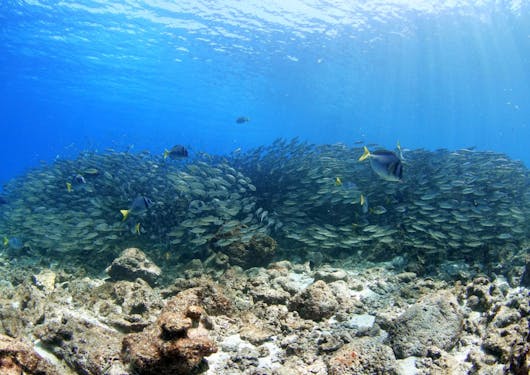
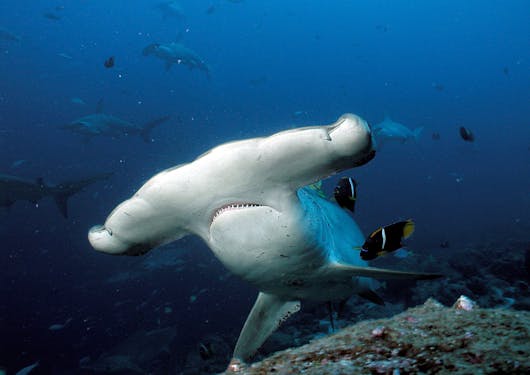
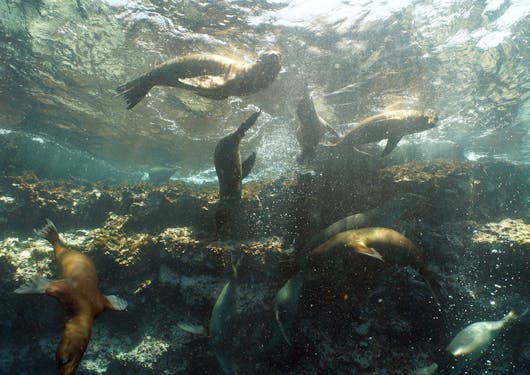
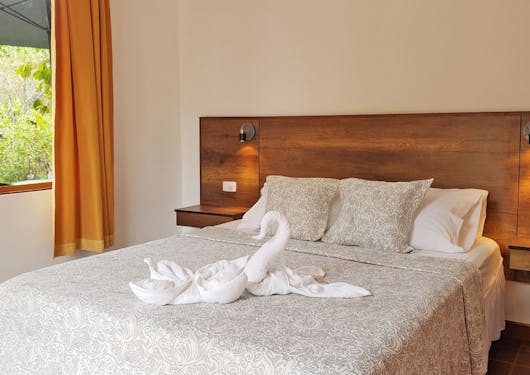

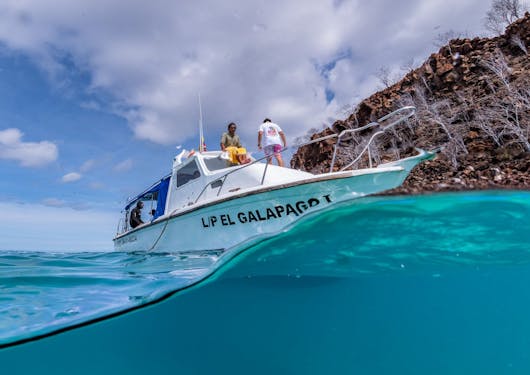
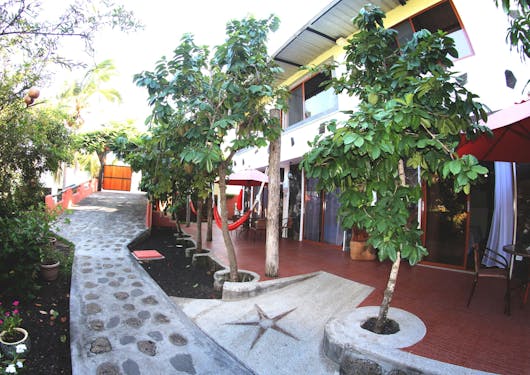
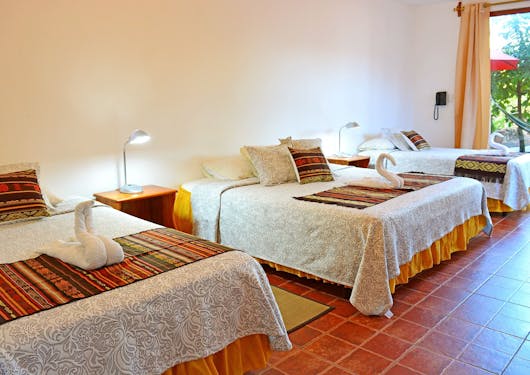
Dive sites depend on the day of the week.
- Monday: Floreana
- Tuesday: Gordon Rocks (only for divers with 25+ dives)
- Wednesday: North Mosquera / Seymour Channel
- Thursday: Bartolome / Cousins Rock
- Friday: South Mosquera / Daphne
- Saturday: Seymour Northeast / Seymour Channel
- Sunday: Punta Carrion / Gordon Rocks (only for divers with 25+ dives)
Here is what to expect at each dive site:
FLOREANA
- Location: South of Santa Cruz Island, 3 possible dive sites: Punta Cormorant, Champion, and Enderby; it is 1 and a half hours away from our base.
- Site Conditions: Depth of 18m. Normally, the sites do not present strong currents. Reef dives where corals and sponges can be found.
- Activity: Cleaning station, sea lions, Galapagos sharks, white tip reef sharks, red-lipped batfish, turtles, reef fishes, sting rays, eagle rays, barracudas, and various invertebrates.
GORDON ROCKS
(Min. experience to participate: 25 logged dives or the previous evaluation of our dive guides at another site.)
- Location: North of Santa Cruz Island, 2 dive sites located 30 minutes from the Itabaca Channel.
- Site Conditions: This rock formation is a world-renowned site. It is only for intermediate and advanced divers due to the strong currents and surges.
- Activity: Hammerhead shark, cleaning station, Galapagos sharks, white tip reef shark, mobulas (devil rays), turtles, reef fishes, sting rays, eagle rays, Galapagos eel, barracudas, and various invertebrates.
NORTH MOSQUERA
- Location: North side of Santa Cruz Island between North Seymour Island and Baltra Island. This is an islet that emerges from the sea (sand bar), one dive site located 25 minutes from the Itabaca Channel.
- Site Conditions: Normally, there are no strong currents and a sandy bottom around 10 meters with garden eels and pelagic species. North Mosquera presents a sandy rock area that connects with Seymour Channel, where reef fishes and sharks rest.
- Activity: Hammerhead sharks, Galapagos sharks, black tip reef sharks, white tip reef sharks, sea lions, turtles, barracudas, reef fishes, sting rays, eagle rays, mobulas (devil rays), Galápagos eels, and various invertebrates.
SEYMOUR CHANNEL
- Location: North of Santa Cruz Island, 2 dive sites located 25 minutes from Itabaca Channel (North side of Santa Cruz Island).
- Site Conditions: For all levels of divers, although sometimes there can be strong currents, platform reefs with a diversity of fish species, a sandy bottom with a 10m reef where there are a lot of reef sharks, and a fish cleaning station.
- Activity: Cleaning station, sea lions, Galapagos sharks, white/ black tip reef sharks, hammerhead sharks, mobulas (devil rays), turtles, reef fishes, sting rays, eagle rays, Galapagos eel, barracudas, and various invertebrates.
BARTOLOME
- Location: Located east of Santiago Island, a small Island with the famous Bartholomew pinnacle, dive sites are located 1.5 hours from Itabaca Channel (North side of Santa Cruz Island).
- Site Conditions: No strong currents to expect. A platform is found at approximately 10 meters of depth where a variety of reef fishes rest. On the edge of this platform, there are underwater cliffs that start at a depth of about 15 meters, with good probabilities to observe pelagic species.
- Activity: White tip reef sharks, reef fishes, barracudas, turtles, mantas, mobulas (devil rays), sting rays, and various invertebrates.
COUSINS ROCK
- Location: North-east of Santiago island near Bartholomew island. Dive sites are located 1.5 hours from the Itabaca Channel (North side of Santa Cruz Island).
- Site Conditions: Normally, there are no strong currents at this site; this is partly a reef dive, partly a wall dive where the endemic black coral is found.
- Activity: Cleaning station, sea horses, barracudas, sea lions, Galapagos sharks, white tip reef sharks, turtles, reef fishes, sting rays, eagle rays, various invertebrates. At surface intervals, penguins can be observed.
SOUTH MOSQUERA
- Location: North side of Santa Cruz Island, between North Seymour Island and Baltra Island, this is an islet that emerges from the sea (sand bar), one dive site located 25 minutes from Itabaca Channel.
- Site Conditions: There are no strong currents; a big reef of 5 meters with an inclined ravine with black coral and mollusks invertebrates; there is also a submarine rift from 18 meters with pelagic species.
- Activity: Hammerhead sharks, black tip reef sharks, white tip reef sharks, sea lions, turtles, barracuda, reef fishes, sting rays, eagle rays, mobulas (devil rays), Galápagos eels, and various invertebrates.
DAPHNE
- Location: North of Santa Cruz Island, an exposed rock, one dive site located 30 minutes from Itabaca Channel (North side of Santa Cruz Island).
- Site Conditions: Moderate currents, rocky and sandy bottom. Here we find a small cave (this is NOT a cave dive) where white-tip reef sharks rest. Additionally, there is a pinnacle where we can find a diversity of rays, Galápagos sharks, turtles, coral reef fishes, barracudas, black coral walls, and various invertebrates.
- Activity: Cleaning station, barracudas, sea lions, Galapagos sharks, white tip reef sharks, turtles, reef fishes, mantas, sting rays, eagle rays, and various invertebrates.
SEYMOUR POINT
- Location: North side of Santa Cruz Island, located 30 minutes from the Itabaca Channel.
- Site Conditions: A bit more difficult in relation to Seymour Channel. Rocky bottom with small caves at 12m where you can find turtles or reef sharks resting; currents are possible (not too strong). The dive starts on the coast and then goes into the blue to watch bigger pelagics. At the end of the dive, there is a platform where sea lions play with the flow, and a cleaning station.
- Activity: Cleaning station, sea lions, Galapagos sharks, white tip reef sharks, hammerhead sharks, mobulas (devil rays), turtles, reef fishes, sting rays, eagle rays, Galapagos eel, barracudas, and various invertebrates.
PUNTA CARRIÓN
- Location: Punta Carrion is located northeast of Santa Cruz Island.
- Site conditions: Punta Carrión is a site with high ecological value due to the mangrove ecosystems that harbor an extensive variety of marine species and marine-coastal birds. This dive site offers ideal conditions for beginners and advanced divers as it has a protected area at the beginning of the dive with calm sea, and no currents at the sandy/rocky bottom full of marine life, before reaching the gorge exposed to the currents. This outer side, with its swell and currents ranging from moderate to strong, offers favorable conditions for pelagic species.
- Activity: The mangrove areas that offer protection to small fish allow this place to have a great variety of reef fish such as angelfish, butterfly fish, surgeonfish, grunts, snappers, damselfish, cod, scorpion fish, parrotfish, old Mexican, stonefish, hedgehog fish, trumpet fish, cornet fish, moray eels, and tiger eels. Also, sea turtles can be spotted, as well as different species of rays such as skates, marbled rays, eagle rays, giltheads, mobulas (devil rays), and different species of sharks such as white tips, Galapagos sharks, hammerhead sharks, and black tip sharks.
Seasonal Notes
The climate of the Galapagos Islands is subtropical.
- December to May: Warm season. Low 80°F/26°C – High 90°F/32°C, strong sun and rain alternately; warmer and calmer seas.
- June to September: Cool season. Low 60°F/15°C – High 70°F/20°C, mornings are often misty; the drizzle ‘garua’ is common.
- October to December: Dry season. Low 70°F/20°C – High 80°F/26°C, it's a good time to visit for mild weather conditions.
Below are specifics about the dive conditions:
- January to June: 70°F/20°C – 80°F/26°C water temperature; southeast trade winds become weaker, and water coming from the Panama Basin brings warmer, calmer seas; sailing to any island/dive spot is easier.
- July to December: 65°F/18°C – 75°F/23°C water temperature; the Humboldt Current typically brings choppy seas and strong surges making sailing times longer.
The Humboldt Current, like the upwelling of the Cromwell Deep Current off the Galapagos Islands, makes the waters quite cold for divers. Thermoclines even colder than 65°F/18°C are possible. We provide 5 or 7mm wetsuits and have accessories such as hoods. If you are not used to cold seas, or if you feel cold easily, please feel free to bring an extra base layer.
The itinerary below is based on Package A, the 7-day dive and stay with 4 dives across 2 dive days.
Packages B, C, and D are described at a high level in the "Customization for Certified Divers" section. Contact us for more details or to design a custom package with more diving, snorkeling, or visits to uninhabited islands.
We can also organize a PADI Open Water Dive Certification during your stay upon request.
All packages may vary slightly based on availability for your dates and any customizations requested.
Itinerary
Day 1 Arrival (Baltra Island); Tour of Santa Cruz Island
Days 2-3 Santa Cruz Dives
Day 4 Free Day: Tortuga Bay, Las Grietas, & Puerto Ayora
Days 5-6 Uninhabited Islands Tours
Day 7 Departure Day
Customization for Certified Divers
Route Map

Inclusions & Exclusions
Accommodation with breakfast
Dives mentioned
All dive equipment, including towel service
All transfers to/from dive sites
Snorkeling equipment (mask, snorkel, fins; if package includes snorkeling)
Snacks, lunches, & non-alcoholic beverages on full-day tours
Snacks & non-alcoholic beverages on half-day tours
Bilingual (EN/ES) PADI instructor
Bilingual (EN/ES) naturalist guides for land and snorkel excursions
Transfers to/from Baltra Airport
Taxes
International airfare to/from Baltra
National Park Entrance Fee
TCT (transit card, to be paid on-site)
Lunch on any days off during the package
Dinners
Dive Computer
Tips
Visas
Travel Insurance
Pricing
Prices exclude flights to/from the destination.
Prices are for double room occupancy unless indicated otherwise.
Prices vary based on accommodation level selected: Standard, Comfort, or Superior.
Dive & Stay Packages range from 7-10 days and combine dive days with land excursions. Custom packages can be designed.
Contact us for solo traveler or single supplement pricing.
Deposit per person
50% of trip price
Shared Room - sleeps 2 - price per person
Package A: 7-day package: (4 dives, 2 dive days) Standard: $1,940 pp Comfort: $2,190 pp Superior: $2,450 pp
Shared Room - sleeps 2 - price per person
Package B: 9-day package: (6 dives; 3 dive days) Standard: $2,050 pp Comfort: $2,390 pp Superior: $2,690 pp
Shared Room - sleeps 2 - price per person
Package C: 9-day trip package: (9 dives; 5 dive days) Standard: $2,350 pp Comfort: $2,650 pp Superior: $2,950 pp
Shared Room - sleeps 2 - price per person
Package D: 10-day package: (6 dives; 3 dive days) Standard: $2,780 pp Comfort: $3,480 pp Superior: $3,760 pp
Payment & Cancellation Policy
This trip is available year-round.
At checkout, choose your preferred departure date and pay the deposit. Our local partner requires a 50% deposit; the rest of Yugen Earthside’s standard Payment & Cancellation Policy applies.
Book With Confidence
- Your deposit is fully refundable for 30 days when you book 120+ days in advance and pay by bank transfer.
- If you pay by credit card, the card processing fees are non-refundable.
- We’ll confirm availability for your chosen dates within 3 business days. If confirmed, you’re all set! If not, we’ll help you adjust your dates or refund your deposit.
Sustainability
Carbon removals are included with your booking.
The dive company is locally-owned, and cooperates with the Galapagos National Park and the Charles Darwin Research Station to support their projects to protect the islands.
The accommodation is a locally-owned guest house implementing the following sustainability measures:
- Everything used in the bathroom is biodegradable: liquid soap, shampoo, and bamboo bags for garbage cans.
- There is a big hot water heater (instead of an instantaneous water heater).
- All garbage is thrown away according to the recycling rules.
Health & Safety
Be sure you have traveler's insurance.





Reviews
Carli F.
Sep 15, 2025
Ease your conscience about traveling
What a wonderful idea and company! The mission of Yugen really helps ease my conscience about traveling whilst also keeping sustainability in focus. We had a wonderful time on our 9-day Galapagos dive and stay trip. I'm genuinely surprised by how little coordination was required of us, we just showed up at the given places and given times, and there was 0 confusion or extra communication needed on our end. Thanks to Hilary and her team, I'm hoping more people will be inspired to travel more sustainably.
Evan A.
Sep 3, 2025
Wouldn't have changed a thing!
It was the perfect mix of scheduled time and free time. We felt all the planning from the transport, to the accommodations, to the activities went as smooth as it could have. I don't think we would have changed a thing! We are very grateful for all the help!
Caity Z.
Sep 9, 2024
Amazing experience...and sustainable!
We had an amazing experience working with Yugen Earthside! From start to finish, we were supported in organizing our trip and answering any and all questions that came our way. We had an incredible experience in the Galapagos and fell in love with the local staff and the unique landscape! Very happy to know that such an amazing trip was also a sustainable choice!